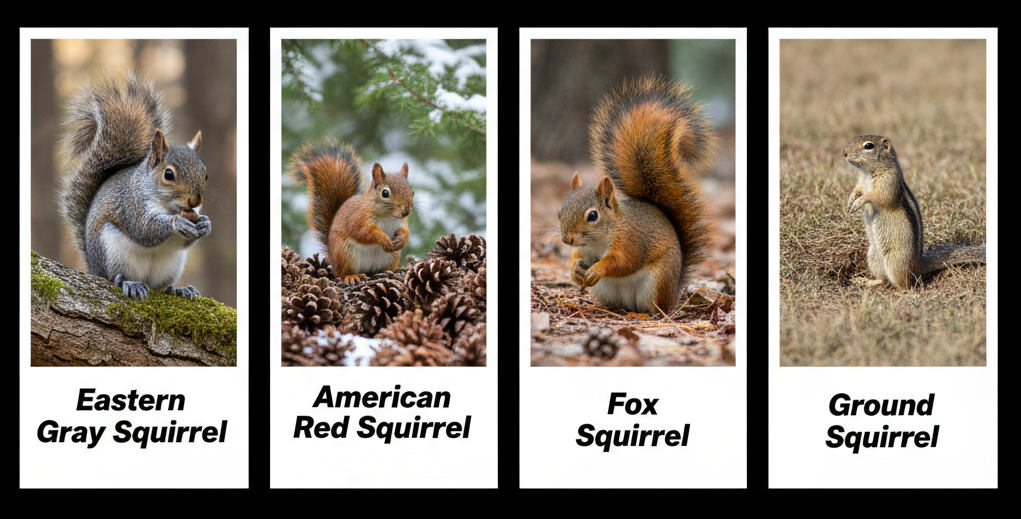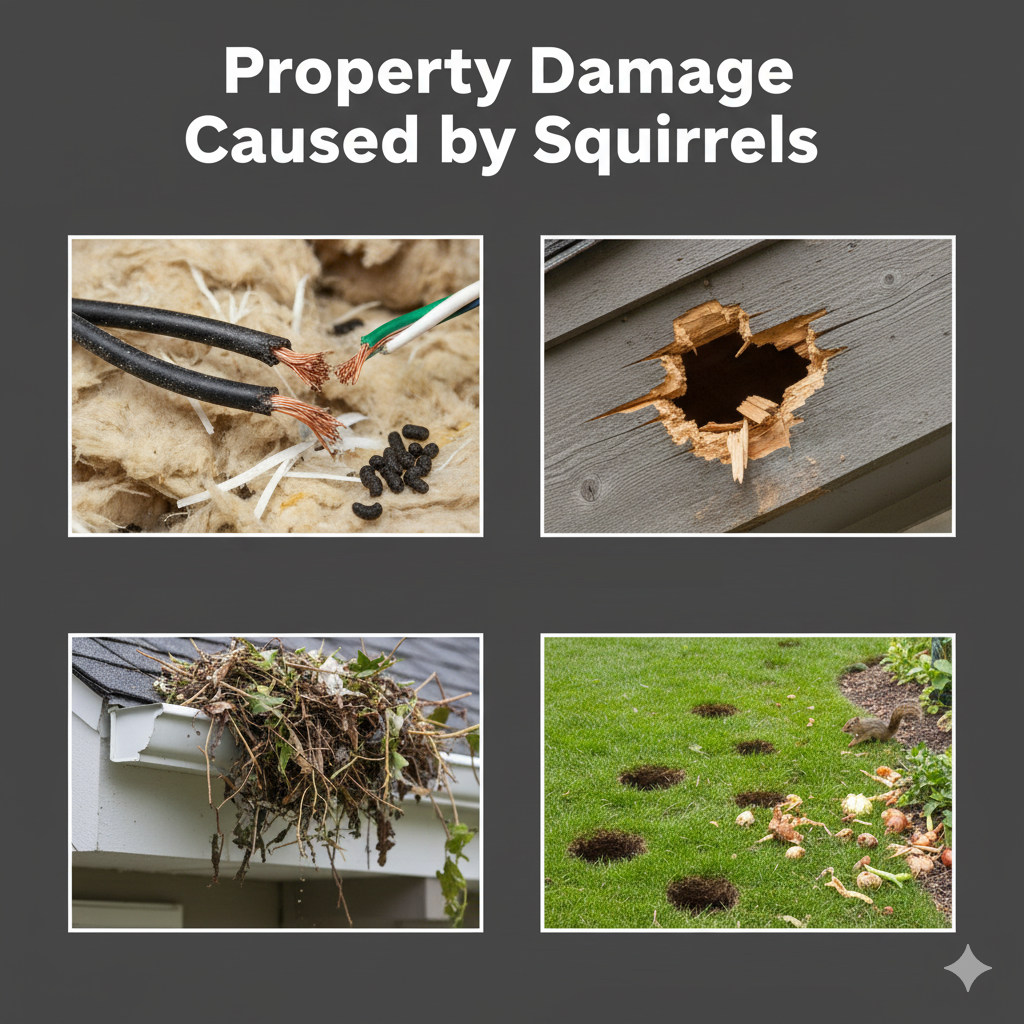How Long Do Squirrels Live? Complete Guide to Squirrel Lifespan, Behavior, and Control
One of the most common questions homeowners ask is: “how long do squirrels live?” Understanding squirrel lifespan is crucial, especially when dealing with potential infestations.
Squirrels are among the most recognizable wildlife species across the United States and Canada. While fascinating to observe in nature, these creatures can become problematic when they invade homes and properties.
According to the National Wildlife Federation, there are over 200 species of squirrels worldwide, with several species commonly found in North America.
Understanding their lifecycle, behavior, and potential risks is essential for effective Wildlife Management and prevention.
Common Squirrel Species in North America
Eastern Gray Squirrels (Sciurus carolinensis)
These are the most common species found in deciduous forests and urban areas throughout the eastern and midwestern U.S. They feature gray fur with a white underbelly and thrive everywhere from suburban backyards to remote woodlands.
American Red Squirrels (Tamiasciurus hudsonicus)
Red squirrels inhabit coniferous forests across the northern U.S. and Canada. Known for their reddish fur and territorial nature, these squirrels are smaller but more aggressive than gray squirrels.
Fox Squirrels (Sciurus niger)
Common in the southern and central U.S., fox squirrels are larger than other tree species. They sport a rusty orange coat and bushy tail, making them easily identifiable in oak and pine forests.
Ground Squirrels (Spermophilus spp.)
Unlike tree-dwelling species, ground squirrels are burrowing animals that live in open grasslands and meadows. The California ground squirrel (Spermophilus beecheyi) has brown or tan coloring that helps them blend into prairie grasses.

Image Source: Generated with Google’s AI
The Squirrel Life Cycle
Breeding Season and Gestation Period
Squirrels are prolific breeders with two breeding seasons annually:
- First breeding season: February through March
- Second breeding season: June through August
During mating season, squirrels become territorial and aggressive. You may notice louder sounds, chasing behavior, and increased activity.
Gestation periods by species:
- Eastern Gray Squirrel: 44 days
- Fox Squirrel: 44 days
- Red Squirrel: 38 days
- Flying Squirrel: 40 days
- Ground Squirrel: 30 days
Birth and Development
Baby squirrels,called kits or pups,are born completely helpless. Newborns are blind, hairless, and weigh only 0.5 to 0.65 ounces. A typical litter ranges from two to six babies, though some can contain up to ten kits.
Pregnant females seek protected areas to raise their young. While they normally build tree nests called dreys, they often invade attics, walls, chimneys, and crawlspaces for safer nesting sites.
The weaning process begins around six weeks of age, though some species nurse for up to twelve weeks. By nine months, young squirrels reach maturity and leave to establish their own territories.
How Long Do Squirrels Live?
So, how long do squirrels live in different environments? The answer varies significantly between wild and captive squirrels.
In the wild:
- Eastern Gray Squirrel: 6-12 years
- American Red Squirrel: 5-10 years
- Fox Squirrel: 8-18 years
- Ground Squirrel: 3-6 years
In captivity: Squirrels can live up to 20 years due to protection from predators and consistent food sources.
The question “how long do squirrels live” depends heavily on environmental factors. Wild squirrel mortality rates are high,approximately half the population dies each year. Common threats include predators (hawks, owls, coyotes, bobcats, snakes), parasites, diseases, and car collisions.
The Humane Society notes that while squirrels are adaptable creatures, their survival in urban environments presents unique challenges.
How Long Do Squirrels Live in Your Home?
Many homeowners wonder how long do squirrels live when they nest in attics or walls. If squirrels establish themselves in your home with access to shelter, food, and water sources, they can live for many years,significantly longer than their wild counterparts.
The protection from natural predators and harsh weather conditions means your attic could house squirrels throughout their entire lifespan, potentially hosting multiple generations if left unaddressed.
Squirrel Behavior and Habits
Activity and Hibernation
Most tree squirrels and flying squirrels don’t hibernate. They remain active year-round, relying on sheltered dens, fat reserves, and food caches to survive winter.
Ground squirrels do hibernate. The Richardson’s ground squirrel may hibernate for several months, while other species hibernate for shorter periods.
Food Caches
Squirrels create underground stockpiles of nuts and seeds. Gray squirrels create thousands of individual buried caches, while red squirrels work together to create communal hoards. They also forage for insects, bird eggs, mushrooms, and animal bones.
Chewing Behavior
As rodents, squirrels have continuously growing teeth that must be worn down through constant gnawing. They can chew through wood, plastic, rubber, drywall, fascia boards, shingles, and even metal,especially problematic when nesting in structures.
When Squirrels Become Pests
Common Infestation Locations
Attics provide warmth, insulation, and safety from predators,ideal for breeding and nesting. Unfortunately, squirrels chew through electrical wires (creating fire hazards), damage insulation, and compromise structural integrity.
Walls and wall voids offer cozy nesting places. You’ll hear scratching or squeaking sounds, particularly during breeding season (March-April and August-September).
Chimneys offer warmth, but squirrel nesting materials,twigs, leaves, and moss,are highly flammable and block ventilation, creating fire hazards.
Gutters become nesting sites that lead to drainage issues and water damage. Squirrels also chew on fascia boards and shingles.
Yards and gardens suffer from squirrels digging up bulbs and vegetables. Ground squirrels create extensive burrows that damage lawns and create tripping hazards.
Signs of Infestation
- Visible sightings during daytime
- Scratching and scampering sounds in walls or attics
- Chewed entry points around rooflines and vents
- Droppings and urine stains
- Nests made of insulation and leaves
- Damaged electrical wires and insulation
- Holes dug in yards or debarking on trees
Property Damage
Squirrels cause fire hazards from chewed wires, structural damage from gnawing, water damage from blocked gutters, reduced energy efficiency from insulation damage, and garden destruction.
If trapped without food and water, squirrels survive only two days. With water access, they might last eight days to two weeks,either scenario creates unpleasant odors and attracts other pests.

Image Source: Generated with Google’s AI
Health Risks
Diseases from Bites
Though healthy squirrels typically won’t bite unless provoked, their bites can transmit tularemia, typhus, plague, ringworm, and rarely rabies. Squirrels can also carry a fatal roundworm brain parasite with rabies-like symptoms.
The Centers for Disease Control and Prevention (CDC) emphasizes the importance of avoiding direct contact with wild animals to prevent disease transmission.
If bitten, seek medical attention immediately. Record details about the incident, including the squirrel’s behavior and condition.
Parasites
Squirrels carry fleas, ticks, and mites that pass to humans and pets. Ticks can transmit Lyme disease, encephalitis, and Rocky Mountain spotted fever.
According to the Environmental Protection Agency (EPA), protecting your home from wildlife-borne parasites is crucial for family and pet health.
Prevention Tips
Structural prevention: Seal entry points with steel wool or hardware cloth. Trim tree branches at least 6-8 feet from your roof. Install mesh screens on vents and chimney caps. Remove stacked objects near your home’s exterior.
Environmental management: Use squirrel-proof bird feeders and clean spills regularly. Never feed squirrels. Install wildlife barriers around gardens. Remove fallen fruit and nuts. Secure garbage in lidded receptacles. Use motion-activated deterrents.
Timing: Be especially vigilant during breeding seasons (February-March and June-August) when pregnant females seek nesting sites. Ensure no babies are trapped when sealing entry points.
Professional Squirrel Removal
When to Call Professionals
Contact wildlife removal specialists immediately if squirrels are in difficult-to-access locations, baby squirrels are present, extensive damage has occurred, or you’re concerned about disease exposure.
At SafeHome Pest Services, we offer safe and humane wildlife removal services throughout Toronto and the GTA. Our licensed experts specialize in squirrel removal using eco-friendly, pet-safe, and non-lethal pest control methods.
Humane Removal Methods
Professional services use live traps for safe relocation, exclusion techniques with one-way doors, permanent sealing of entry points, damage repair, and sanitization of affected areas.
The National Pest Management Association (NPMA) recommends professional wildlife control services for safe and effective removal.
We use eco-friendly, pet-safe, and child-safe treatments throughout the entire process, ensuring safety for both squirrels and your family.
What to Expect
Wildlife removal specialists will conduct property inspections, identify entry points, determine if babies are present, implement humane removal strategies, seal vulnerable areas, sanitize affected spaces, and provide prevention recommendations.
At SafeHome Pest Services, we serve Toronto and neighboring areas including Brampton, Mississauga, Woodbridge, Vaughan, North York, Etobicoke, Richmond Hill, Markham, and Thornhill.
Call us at 416-548-8060 for same-day emergency service or request a free quote online.
Special Considerations
Baby Squirrels
If you find baby squirrels, they likely haven’t been abandoned,the mother is probably gathering food. Never handle babies yourself, as mothers may attack, babies can carry diseases, and you could separate families.
Squirrels in Trees
Tree nests (dreys) are natural and part of a healthy ecosystem. However, if trees are too close to your home, professional trimming may be necessary.
Conclusion
Squirrels can live 6-12 years in the wild and up to 20 years in captivity. When they invade your home, a single family can occupy your property for years, causing extensive damage and health risks. Prevention through regular maintenance is crucial, but if you’re already dealing with an infestation, professional help is essential.
Don’t let squirrels take over your home. SafeHome Pest Services provides safe, humane squirrel removal throughout Toronto and the GTA. We’re proud members of the NPMA and CPMA, offering eco-friendly solutions that protect your family and property.
Call 416-548-8060 now for same-day emergency service or visit our website to schedule your free inspection. Act today to protect your home from costly damage.
Frequently Asked Questions About Squirrels
- What is the average lifespan of a squirrel living outside?
In the wild, most squirrels live between 5 to 10 years, depending on the species and environmental conditions. However, many don’t survive their first year due to predators and harsh weather.
- How long do squirrels live in the wild?
Wild squirrels generally live around 6 years on average, though some may reach up to 12 years if they avoid predators and find consistent food sources.
- At what point should we consider removing squirrels permanently?
If squirrels begin nesting in your attic, walls, or roof, or you notice chewed wires, droppings, or loud scratching sounds, it’s time to contact a wildlife removal professional. Removal prevents property damage and potential health risks.
- How long can a squirrel live without food or water?
Squirrels can typically survive no more than 2–3 days without water and around 5–8 days without food. Their high metabolism means they must eat and drink regularly to stay active and healthy.
- How do hibernating squirrels survive for months without water?
Tree squirrels don’t truly hibernate but remain less active, living off stored food and body fat. Ground squirrels, which do hibernate, survive by lowering their metabolism,their bodies use less water and energy during the cold months.
- What is the average lifespan of a squirrel in Canada?
In Canada, squirrels live about 6 to 8 years in the wild, though life expectancy varies with climate, food availability, and predators like hawks and foxes.
- Where do squirrels live in winter?
During winter, squirrels stay in dens or nests made of leaves and twigs, usually inside tree cavities or attics. These shelters protect them from freezing temperatures and snow.